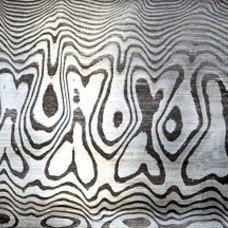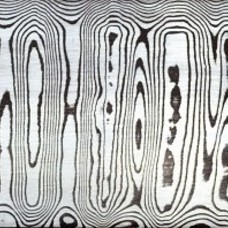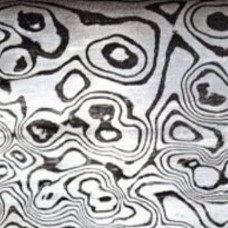Tradition Stainless Steel Damascus
Hoogwaardig damaststaal uit eigen smederij, roestvast en gemaakt van bekende messen staal soorten. Vraag naar de mogelijkheden!
Wellicht wil je het staal ook etsen, voor een mooie patina, om de Hamon (hardingslijn) meer contrast te geven, óf om je Damastpatroon zichtbaar te maken? Hier vind je tips
Onderstaand informatie over het staal in het Engels > Aan de vertaling wordt gewerkt.
About our Stainless Steel Damascus
- What is it made of?
- In what state/condition is the steel
- Is it possible to buy this ‘Precision ground’?
- What sizes are available?
- Does it need to be tension annealed before hardening?
- What is the hardening procedure?
- What is the maximum achievable hardness?
- What can I etch it with to make the patterns visible?
- What is it made of?
These Damascene steels are made of well known knife –and tool steels such as ATS-34, 440C, 154 CM, 19C27 and D2. The molecular structure of the steel is very fine, and it has outstanding working characteristics.
- In what state/condition is the steel?
It is soft annealed (app. 24 HRC) in a very exact heat treatment procedure. Therefore it is very easily workable (sawing, drilling, grinding). Stainless, of course, is a bit tougher than Carbon steels.
- Is it possible to buy this ‘Precision ground’?
Yes, but we also sell black (not ground) stock on request.
- What sizes are available?
Usually we have a modest stock available, but we also work on order.
Regular sizes are 30x3 mm, 40x2.5, 40x3 and 40x4 mm.
For special requests please call on office hours CET on +31 (0)722029010, or send us an e-mail at [email protected]
- Does it need to be tension annealed before hardening?
When the right grinding methods are used (do not overheat), this is not necessary. When the work piece has fallen (or endured any impact), of in any other way increased internal tension, we do recommend it anyway. We can arrange this service for you. You can tension anneal this material by heating it up to 720°C (1328F) under protective atmosphere.
- What is the heat treatment procedure?
As with any high-alloy steel, a very secure hardening procedure is necessary to obtain the best properties possible. In these procedures the temperature and the duration of heating and cooling are very strictly regulated. In this way the molecular structure of the steel can be optimally formed, (every alloying ingredient on the right place in the steel structure) which will optimize the cutting properties, corrosion resistance, duration and toughness.
We strongly advise salt bath or (semi-)vacuum oven hardening. The absence of oxygen will prevent carbon loss.
Hardening: Heat on 1060°C (1940F) in protective environment (vacuum) and cool in oil.
Tempering: Heat between 180°C (356F) and 300°C (572F) for two hours in protective environment (vacuum) and then cool in air.
190°C (374F) = 60/61 HRC (660 HB)
225°C (437F) = 58/59 HRC (620 HB)
Maximum hardness before tempering is 62 HRC (688 HB)
- What is the maximum achievable hardness?
When optimally hardend, the end result is 61 HRC (670 HB)
- What can I etch it with to make the patterns visible?
To enhance the visibility of the patterns the most commonly used method is etching. Beautiful contrasts are achieved using hydrochloric acid (HCL). Please be very careful when using acids! Very well polishing and slow etching for the best results.
Please enjoy our steel! May there be anything, don’t hesitate to contact us for advice, inquiry or comments.
Thank you for your interest.
Best Regards on behalf of the team,
Renske Schuyt -van Wijngaarden
Smederij Atelier Alkmaar





